Menu
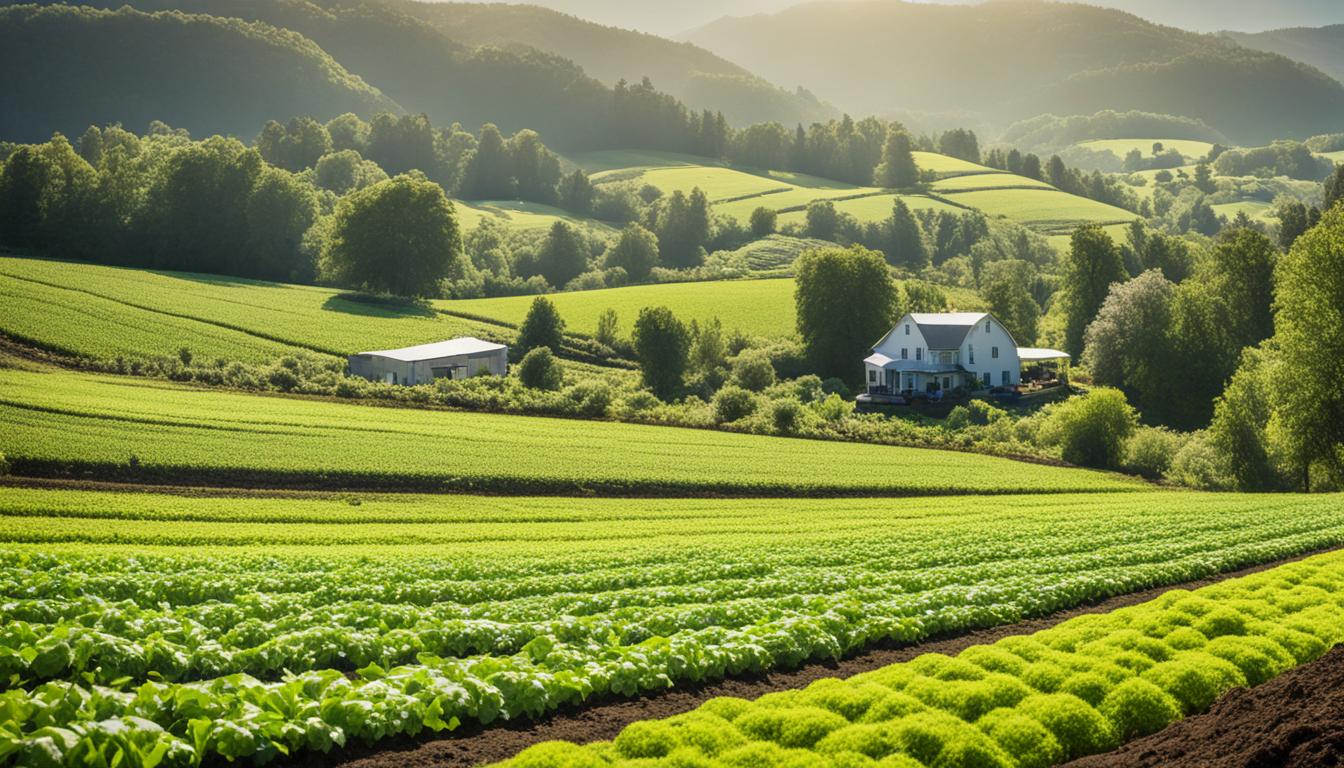
Do you know what sustainable crop management means? It’s all about using non-renewable resources wisely. This way, we can make sure there’s enough food and fibre for everyone now and later. With the world’s population growing, the need for food, fibre, and livestock forage is getting bigger. This makes sustainable crop management very important. We need to find ways that use resources well and take care of the environment. For example, using drip irrigation means we can grow more crops while using less water, about 20-40% less.
Today, sustainable farming is more than just using resources well. It also means moving towards renewable energy and being careful with land. It’s about following advice from experts at the Food and Agriculture Organization (FAO) on five key points. Also, new technology that uses satellites is making farming smarter. This tech gives farmers better information, helping them use resources more efficiently. All this is leading to a big change in how we farm sustainably.
Sustainable crop management is key to keeping agriculture stable for the future. It seeks to save resources for those yet to come. This method mixes several important goals into farming. The Food and Agriculture Organization (FAO) talks about the vital principles. These include making the food chain more efficient, keeping the environment safe, and helping both economic growth and local communities. These rules are a guide for reaching the main goals of sustainable farming.
The aim of sustainable agriculture is to keep farm productivity high for the long term while protecting the earth. It wants to keep the soil rich, increase the variety in nature, cut down on pollution, and use less of what we can’t replace. These ideas are meant to help not just farms but also the people who live there and the environment. They try to balance making money, supporting society, and protecting nature to meet the needs now without hurting the future.
Sustainable agriculture is very important in today’s farming. It helps food stay safe by making farms strong and able to change. Things like growing different crops, planting over fields, and not disturbing the soil help to keep the ground healthy, stop it from washing away, and control pests. Also, by managing pests carefully, it’s possible to use fewer harmful chemicals. Putting trees and bushes in fields – known as agroforestry – makes more kinds of plants and helps bring in extra money. In this way, the goals of sustainable farming match well with new techniques to keep farming for a long time.
Ensuring there’s enough food today is hard, needing many different efforts. Farms that use a mix of methods and look at the whole area are important for stopping soil loss, dealing with too many nutrients in the water, and helping nature thrive. Since World War II, farming has been getting more and more productive thanks to machines, chemicals, and new ways of working. But in the last forty years, people have been turning towards sustainable farming, aiming to keep the earth healthy, make money, and be fair to everyone. This new way wants to make farming strong enough to face what’s coming next.
Good sustainable farming methods are key to making the food chain better. They also protect the environment. This means using ways of farming that keep the land and ecosystem healthy.
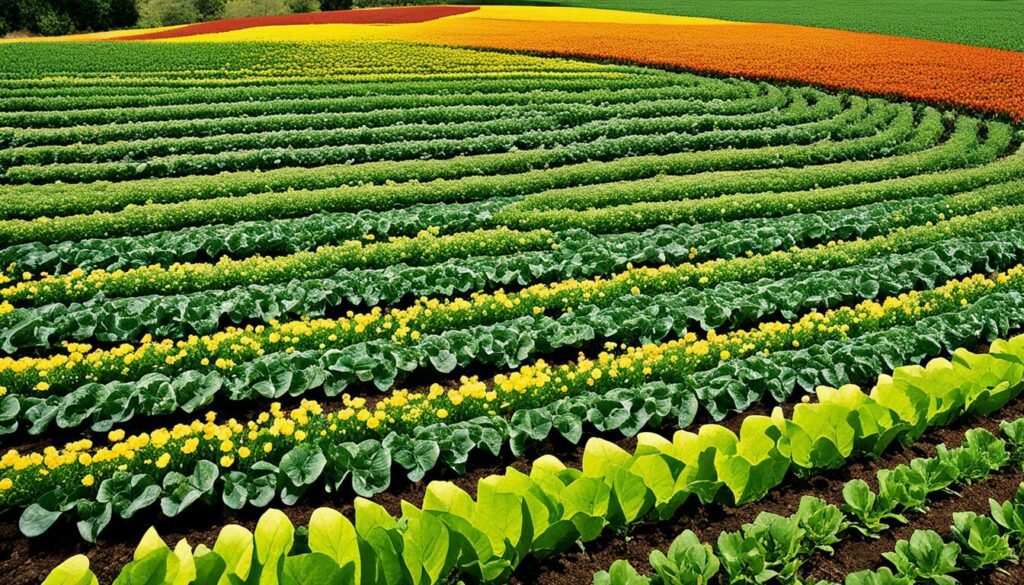
Using sustainable methods boosts how much food we can grow. Things like growing different crops each year and planting crops together make the soil better. This reduces the chance of diseases in crops and increases how much food we get.
“Diverse and complex agricultural systems tend to be more sustainable and productive.” – Agricultural Research
Dealing with pests well without too many chemicals is important. Integrated pest management (IPM) combines many ways to control pests. This is safer and cheaper than just using chemicals.
Taking care of where we grow food is important for the planet. Ways like planting special crops in between main crop seasons help. These special crops keep the soil healthy and reduce using harmful chemicals.
Not turning the soil often also helps the ground stay good. This is called no-till or reduced-till farming. It stops the soil from losing important nutrients.
Key Strategies:
Having animals on the farm as well can make farming better. For example, they can eat leftover crops. This can also make the farm more profitable.
| Practice | Benefit |
|---|---|
| Crop Rotation and Intercropping | Makes soil healthier and fights off pests |
| Cover Crops and Perennials | Stops soil erosion, adds back nutrients, and needs less fertiliser |
| No-Till or Reduced-Till Methods | Keeps soil from losing nutrients and makes it healthier |
| Integrated Pest Management (IPM) | Uses less chemical pesticides |
Using trees and shrubs on farms is a good idea too. They provide shade and a place for animals. They can also be sold for food, which is an extra way for farmers to make money. These practices make sure the food chain keeps working well without hurting the earth.
Taking up eco-friendly farming is key for our future. It moves away from harmful chemicals. Instead, it uses organic substitutes. For example, farmers use plants to fix nitrogen in the soil instead of chemicals. This makes the environment healthier and lower our impact.
Sustainable agricultural practices include using natural pest control. Integrated pest management (IPM), reduces chemical use by 40% without losing effectiveness. Also, not tilling the soil much cuts down on erosion, helps the soil stay healthy, and raises crop yield by 10%.
Cover crops in the off-season can lower soil erosion by 30% and bring back 25% of soil nutrients. These practices keep the soil good for farming, a big part of environmentally conscious farming. Mixing different plants and rotating crops help the soil stay fertile and cuts down losses from pests by 15%.
Agroforestry is another important method. It helps the soil and water. Plus, it adds 10-15% more income from fruit and nut crops. Also, having livestock with crops can make the farm 15% more efficient and profitable. This shows a balanced way to run farms to benefit both the economy and the environment.
Using these sustainable agricultural practices brings big wins. It can up crop yield by 30% and make the soil keep water better. It also cuts pollution by 20%. These results show a strong move towards farming that protects nature, benefiting agriculture and our planet.
Keeping soil healthy is key in farming for the long term. By using methods to protect the ground, we make our farms better and look after the environment.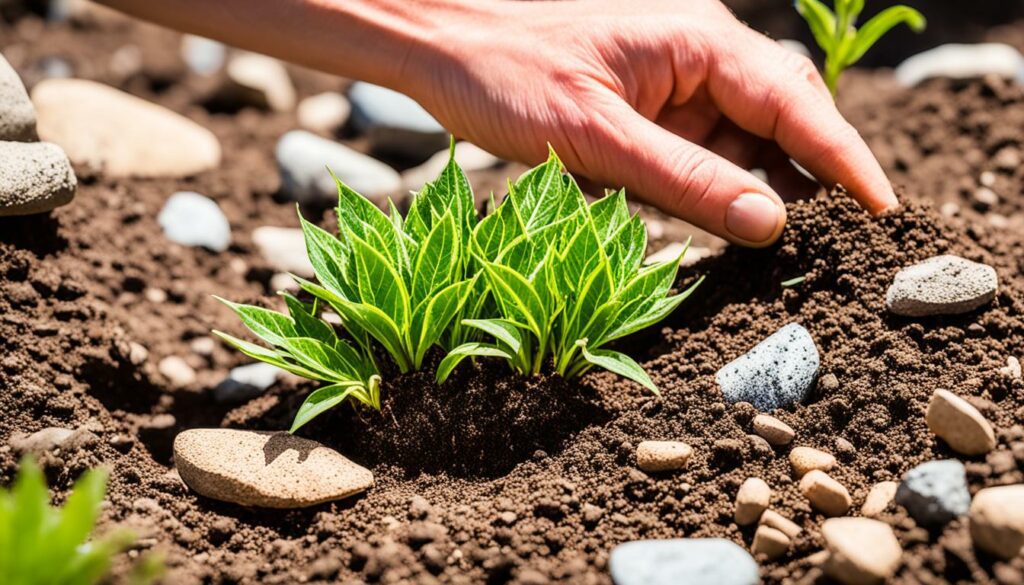
Erosion is a big problem for our soil, but we can fight it. Conservation tillage and no-till farming keep some land covered with plant leftovers. This protects the soil and helps water and farmers save on fuel.
Contour farming and strip cropping work well to stop soil from eroding. Contour farming follows the natural shape of the land. It helps keep soil in place and saves energy. Strip cropping is like a protective wall. It catches mud and slows down water, preventing erosion. Windbreaks also stop the wind from blowing soil away. This extra soil cover helps crops and animals grow better.
We can also make our soil better by rotating crops and using cover. Crop rotation keeps the soil healthy and cuts down on pests. It also means we can use fewer harmful chemicals. Cover crops protect the soil and make it richer. This helps the soil hold water and nutrients better.
| Technique | Benefits |
|---|---|
| No-Till Farming | Reduces erosion, improves water infiltration, enhances organic matter |
| Contour Farming | Reduces field erosion, uses less tractor fuel |
| Strip Cropping | Traps sediment, controls erosion |
| Crop Rotation | Enriches soil, reduces pest/disease incidence |
| Cover Cropping | Protects soil, enhances fertility and structure |
Using these methods helps farmers in many ways. They can grow more food, spend less money, and keep the soil healthy for the future. It’s vital for the farming of today and tomorrow.
Organic agriculture plays a key role in sustainable farming. It has many benefits, like using fewer chemicals. This helps both the environment and our health.
Organic farming helps keep harmful chemicals out of the soil. For example, it doesn’t use sewage sludge. By avoiding these substances, it keeps ecosystems healthier and supports more diverse wildlife. Organic agriculture focuses on using natural methods, boosting biodiversity.
In organic livestock production, animals must have outdoor access. This ensures they can act naturally and stay healthy. This humane approach leads to better food quality. Providing outdoor areas and using rotational grazing improves animals’ lives and the land they graze on.
Organic farming requires using natural feeds and avoiding chemicals. It’s important for farmers to select the right breeds that can thrive where they live. For crops, ingredients should mostly be organic. At least 95% of what’s used has to be certified.
During processing, it’s crucial to keep organic and non-organic items separate. Following strict standards helps keep organic products true to their values. This way, organic farming stays good for the planet and our health.
| Best Practice | Requirement |
|---|---|
| Avoid Sewage Sludge | Organic crop producers must not apply sewage sludge or biosolids to soil. |
| Animal Welfare | Organic livestock producers must provide living areas that encourage health and natural behaviour. |
| Pasture Access | Organic livestock must have access to pasture during the grazing season. |
| Certified Organic Feed | Organic feed for livestock must be certified organic. |
| Processing Integrity | Prevent commingling with non-organic ingredients during processing. |
By strictly following these guidelines, organic farming thrives. It offers many benefits and is in harmony with the natural world.
Sustainable farming is about growing crops that can deal with changing climates. This way, farming can go on even when the weather is tough. It protects both the crops and the farmers’ income from bad weather.
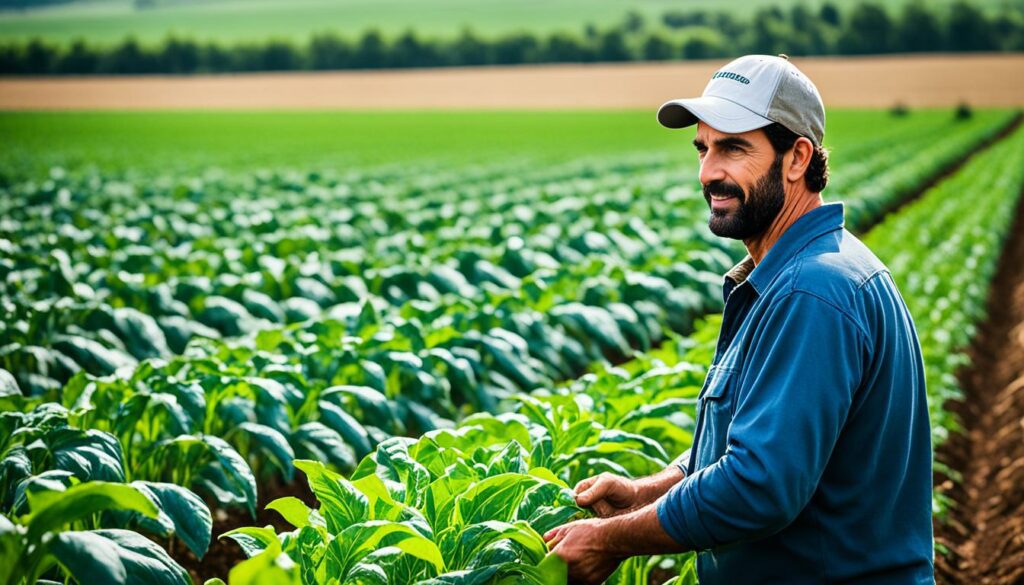
Finding and growing climate-resilient crops is very important. Take alfalfa, for example, which is a top crop in the US. Scientists are changing its genes to be able to handle dry spells, salt, and floods better. They found that certain social factors also play a role in how well new crop types are accepted.
Improving plants to have more leaf lipids can give them extra energy. This technique has boosted energy in forage crops without hurting the plants. By using this approach, we can grow crops that are not only stronger but also help to fight climate change.
Growing crops that deal well with climate change is crucial for the future. Some estimates say that important crops could see their yields drop by 30%. Choosing strong crop types like alfalfa helps keep farms productive, even in tough times.
How well these new crops are embraced depends on many things, like farming education and access to seeds. By offering more help and teaching, we can make sure these helpful farming methods are used more widely.
Precision agriculture technologies are changing the face of modern farming. They provide accurate, real-time data to make better decisions and manage resources well. By using high-tech tools, like remote sensing, farming becomes more efficient and sustainable.
Remote sensing in farming uses satellites and drones to check on crops, soil, and the weather. This means farmers can keep an eye on their fields 24/7 without being there in person. The result? A 4% boost in crop growth and less water used, plus smarter fertiliser use and less fuel burnt.
Precision agriculture boosts how much we can grow by using resources well. For example, it helps apply seeds, fertilisers, and water exactly where they’re needed, reducing harmful chemical use by 9%. So far, this has cut down on herbicide use significantly. Plus, it saved water equal to 750,000 Olympic pools!
But there’s more we can do. With more farms using these technologies, we could make fertilisers 14% more efficient and cut pesticide use by 15%. This could avoid tons of additional chemicals. Only 27% of farms use this tech right now, and wider use could bring big gains.
The USDA says more farms should jump on board. Doing so could mean farming better and cleaner. It’s all about making everyone’s food source more efficient, sustainable, and productive.
Agroecology blends farming with nature, aiming for sustainable agriculture. Its core principles have been found in science since the 1920s. They mimic the stability seen in natural ecosystems. The 13 principles, endorsed in 2019, guide farmers towards practices that keep the balance of nature.
Diversity stands out as a key idea. Farmers use techniques like agroforestry and varying crop planting to boost the number of species and genes around. This ensures there is enough food and helps save the land we farm on.
The FAO highlights 10 key elements for making food systems better. These include working together and sharing knowledge to tackle local problems. Such methods improve both what we produce and the services we get from the environment.
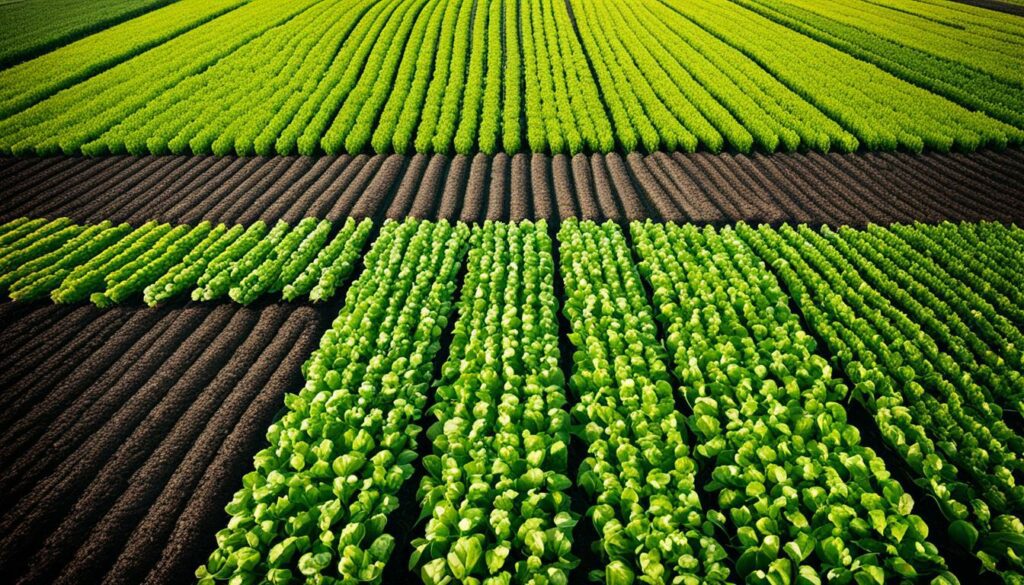
New agroecological methods aim to do more with less, reducing the need for extra materials. This change helps cut down on costs and care for our planet. It’s a big step in making farming more resilient and sustainable.
Caring for the well-being and fairness of people in farming areas is also crucial. By backing up diverse and fitting diets, agroecology supports our need for food while keeping the ecosystem healthy.
Good leadership is needed to make the most of agroecology. This includes responsible rules to overhaul agriculture, helping reach goals like Zero Hunger. It also brings farms and markets closer together, creating new ways to live within the planet’s limits.
Agroecology’s value comes from its way of conserving agro-biodiversity as demands for green products rise. Following these principles means we can also make our society stronger in the face of nature and economic changes.
| Agroecology Principles | Benefits |
|---|---|
| Diversity Optimisation | Enhanced food security, conservation of natural resources |
| Co-Creation and Knowledge Sharing | Innovative solutions for local challenges |
| Resource Recycling | Lower economic and environmental costs |
| Governance Mechanisms | Transformation towards sustainable agriculture |
| Circular Economies | Reconnects producers and consumers |
Using sustainable irrigation methods is key in tackling water scarcity and boosting farm production. 18% of cultivated areas need watering, making smart watering crucial. The use of irrigation increased from 94 million to 271 million hectares between 1950 and 1986. This jump shows how vital irrigation is for growing food. Many now use drip irrigation systems and work hard to save water to make the most of it.
Drip systems are a great way to use less water. They water plants directly, cutting down on waste from water disappearing or running off. Around 40% of water used for growing crops is wasted due to old-fashioned methods. Drip systems help farms grow more food with less water, helping to keep our water supply safe and plentiful for all.
Making the most of water in farming needs smart technology and careful planning. Farming uses 70% of the world’s water. So, there’s a big push to use water better. While old methods like surface irrigation have been common, they’re not good at saving water. Now, things like tanks and special irrigation systems help cut down on waste. Making sure water doesn’t get wasted is super important. Many places already don’t have enough water, and more people are facing this problem every day.
The need to save water is getting more urgent as the planet gets hotter and we grow more food. In places like Pakistan, not having enough water for farm crops is a big issue. It’s even harder to manage water with the higher temperatures. Using water better is crucial for both feeding people and making sure farms can keep going.
In short, drip irrigation is a game-changer for using water wisely in farming. It saves water, boosts crop growth, and keeps farms going strong. This makes farming more efficient and reliable for the future.
| Global Statistics | Details |
|---|---|
| Global Irrigated Land (1950) | 94 million hectares |
| Global Irrigated Land (1986) | 271 million hectares |
| Water Consumption by Agriculture | 70% |
| Water Wastage (Inefficient Practices) | 40% |
| Percentage of Land Facing Water Shortage | Over one-fourth |
| Population near Water-deficient Areas | 35% |
Integrated Pest Management (IPM) is a broad, nature-friendly approach to controlling pests. It uses natural, mechanical, and cultural methods. This way, it avoids the heavy use of chemicals, which can harm the environment and health.
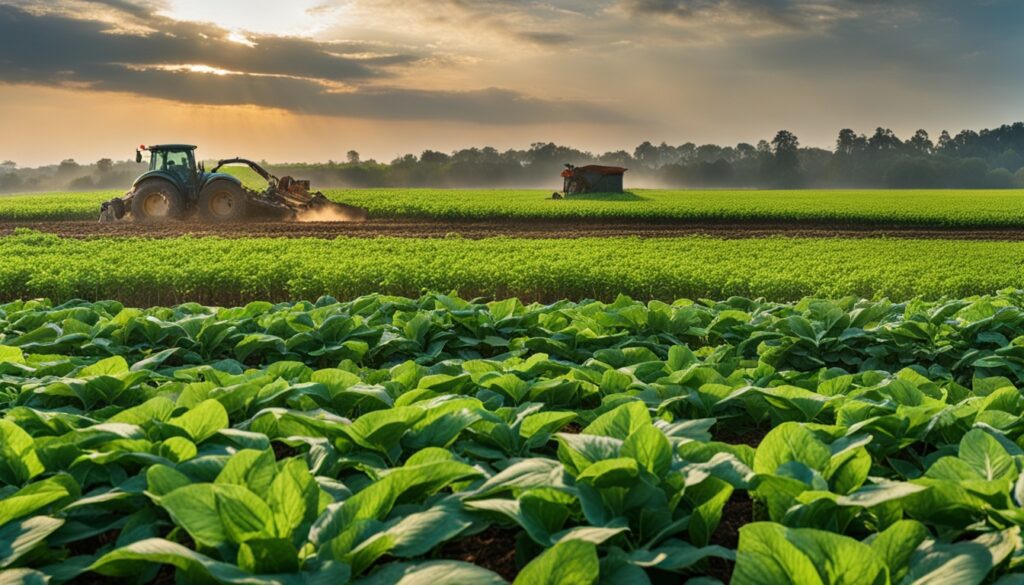
In IPM, biological pest control uses insects or other organisms to manage pests. For example, adding good bugs, nematodes, or certain diseases. This method helps keep pests in check, naturally balancing the environment. It’s a green alternative to using chemicals.
IPM includes both mechanical and cultural ways to deal with pests. Mechanical methods use traps and barriers to stop pests physically. Cultural methods change how we farm to make it hard for pests to live or grow. Things like planting different crops together or changing fields around. This makes conditions not right for pests, but good for crops.
Researchers from the UC Statewide IPM Program share the latest knowledge on IPM. They work with others to keep improving these pest control methods. By using all these tools, IPM helps keep our food safe and the environment healthy.
Using efficient crop rotation is key in sustainable farming. It helps avoid pests and diseases that harm single-crop fields. Also, planting various crops together improves the soil. This leads to better growth over time.
Crop rotation boosts soil health. Different plants need different nutrients and give back different ones. This process reduces the use of harmful chemicals. It also keeps the soil’s structure and moisture, leading to more crops and more profit.
Crop rotation fights pests too. By changing the crops, we make it hard for pests to grow in number. This is a natural way to control pests, lowering the need for chemicals.
Adding diversity to farms makes them more balanced and reduces risks from bad weather. Studies show mixed crop farms outperform those with only two crops. This mix supports more bugs that are helpful and fights off pests.
Having a wide variety also toughens the farm against tough weather. Growing plants like alfalfa and small grains makes the soil stronger. This change protects the farm from climate change.
We must use crop rotation and grow a mix of crops. Doing this helps our farms be more diverse and ready for challenges.
The use of cover crops has grown a lot recently. In 2017, they were used on 15.4 million acres of land. This marked a 50% rise over five years.
This increase shows how important they are in farming today. Cover crops protect the soil from being washed away and add nutrients to it when they break down, acting like ‘green manure’.
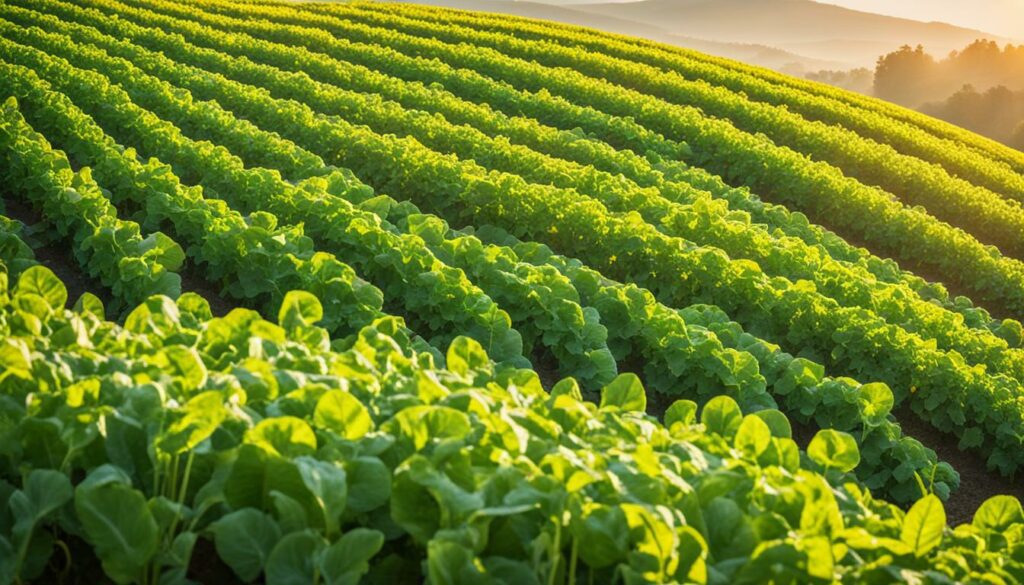
From 2012 to 2017, eight states in the US saw a big jump in their use of cover crops. During the same time, the number of farms using them also went up by 15.2%.
Farmers found that after using cover crops for five years, they got 3% more corn and 4.9% more soybeans. In a very dry year, 2012, these figures were even higher at 9.6% for corn and 11.6% for soybeans.
Cover crops like legumes can add 50-150 pounds of nitrogen per acre, cutting down on the need for nitrogen fertilizer. Others, like cereals, can take in 30-50 pounds of nitrogen per acre if planted in autumn.
Cover crop mixes do a lot. They make more plant material, help control weeds better, and cover the ground well. These mixes also attract useful insects and help pollinators.
It’s a big challenge to add cover crops to crop rotations or start new ones. But, farming without tilling is a good way to include cover crops. This helps water soak in better, keeps the soil moist, and stops weeds.
Cover crops help the environment a lot. They make the soil richer and keep more water in it. This stops the soil being washed away, lessens pollution from farm chemicals, and stops the soil getting too hard. This is really important in places like the Northeast US where heavy rains are making soil problems worse. Using cover crops all the time can make farms more stable and profitable.
Cover crops also help farming’s bottom line. They boost the amount of crops you get, lessen the need for big machines, control weeds, and support good insects. Even though starting with cover crops can be costly because of seeds and such, the benefits in the long run are worth it.
Choosing the right cover crops is key to making them work well. Farmers should try out small areas first to see what works best. Talking to farming experts and going to workshops can give farmers useful tips on how to manage cover crops well.
Sustainable crop management is a holistic farming method. It boosts the economy, helps the environment, and improves social life. Sustainable crop management benefits include big changes all around.
There are big economic advantages to sustainable crop management. It saves a lot of money by being very precise in farming. This means using water and fertilisers better to cut waste and do more with less.
Also, it’s cheaper to farm when you don’t plough as much or use as many chemicals. This kind of farming cuts costs. It also helps the crops to fight off bugs and diseases, so they grow better. This is great for having more food and making sure food is always available. Helping local businesses by buying from them and creating new jobs is another big win.
The sustainability part is also very important. Farming in a sustainable way protects the earth. This way of farming is cleaner, releasing fewer bad gases into the air. Things like planting to cover the earth and using clean energy help fight climate change.
On the social side, farming well means treating people right. Everyone who works on the farms should be paid well, work in safe places, and have their rights looked after. This makes life better in farming areas. Also, teaching farmers new and better ways to farm helps them and the planet.
This type of farming isn’t without its problems, though. It can be hard to make a lot of product this way because you can’t use up all the land. Also, because machines aren’t used as much, more people need to work to get things done. Governments need to step in and help with money, grants, and low-cost loans. This support is needed for this kind of farming to last and do well.
In wrapping up our journey through sustainable crop management, it’s clear this method is key for our food system’s future. After World War II, food and fibre production rose fast, helped by new technologies and policies. But with the world’s population set to hit about 10 billion by 2050, there’s a big demand for farming that meets our needs without harming the earth.
Sustainable farming has gained strong support in the last 40 years. It focuses on being good for the planet, profitable, and fair to people. Farms that can adapt and are diverse are often more successful in the long run. This matches the future needs of agriculture well.
Practices like careful use of water, changing crops each season, and using natural methods help crops grow and keep the food supply safe. They also protect our land, keep wildlife healthy, and fight climate change. Radically efficient water use and clean energy show a real commitment to the planet.
Looking ahead, our goal is to keep making these practices better and more common. This needs work from lots of people in the industry, like farmers, researchers, and educators. Together, we aim for a future where farming supports everyone and looks after our planet. We’re striving for a sustainable, prosperous agriculture ahead.
It means using farming methods to keep producing food without harming the earth. These methods protect the land, help farmers make money, and benefit everyone. They keep the soil healthy, help wildlife, cut down on pollution, and keep small towns alive.
The world’s growing need for food and other farm products makes it key. It makes sure we have enough food, protects nature, and helps the economy and society. This way, farming can be strong not just now but for later generations too.
Important ideas include making the food chain better, taking care of nature, growing the economy, and helping people. These ideas aim to keep a good balance in how we farm for the future.
Being green in farming means using natural stuff instead of chemicals, planting special plants, and keeping pests at bay naturally. This helps the planet and keeps farms in tune with nature.
Farming methods like cover crops and careful ploughing stop soil from washing away. They make the soil richer and healthier. This means the ground keeps on growing good crops for years to come.
Going organic makes food cleaner, makes us healthier, and helps more plants and animals live. It uses natural ways to grow food, leaving the earth and us much happier.
Tough crops can handle different weather, making farming last through tough times. They keep the harvests steady, offering farmers a secure future.
Smart farm tools give farmers the latest field info, letting them make the best choices. This boosts how much food they can grow and saves resources, making things better all around.
Agroecology links farming with the natural world, helping farming’s balance and health. It means less waste and a farming system that keeps going sustainably.
Drip systems get water right to plants, saving a lot. This makes farming more efficient, saves water, and uses less power, all while keeping things green.
IPM is a full plan for dealing with pests that puts nature first. It cuts down on harm to the environment and our health while beating the bugs.
Swapping crops can stop bugs and diseases, keep the soil healthy, and help the ecosystem. It’s key to farming that keeps on flourishing year after year.
They stop the wind and rain from hurting the soil, feed it, and draw in helpful bugs with their flowers. Cover crops are a farming superhero, keeping the land and its life super strong.
Doing farming right can save money, make food safer, and use less energy. All this helps farms and the economy to grow strong.
Good farming means less mess in the air and water, saves nature, and makes for healthier communities. It’s the way to a future where we all do well and the earth thrives.